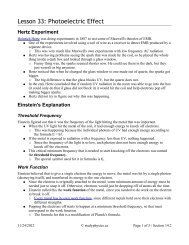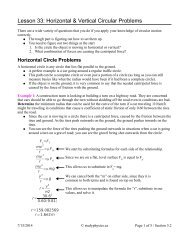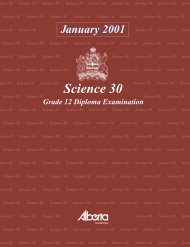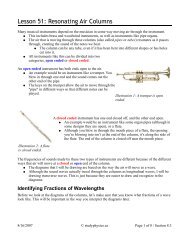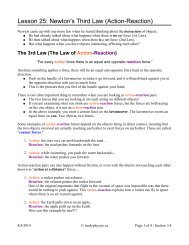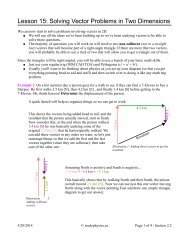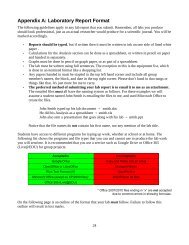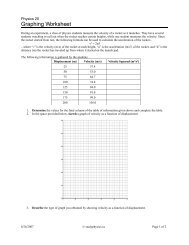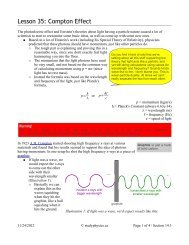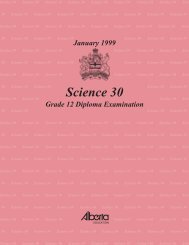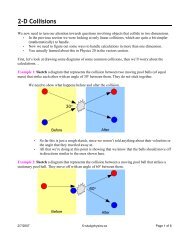June '99 Diploma - Mr. Clintberg's Studyphysics!
June '99 Diploma - Mr. Clintberg's Studyphysics!
June '99 Diploma - Mr. Clintberg's Studyphysics!
- No tags were found...
Create successful ePaper yourself
Turn your PDF publications into a flip-book with our unique Google optimized e-Paper software.
Physics 30 Physics 30 Physics 30 Physics 30 Physics 30 Physics 30 Physics 30 Physics 30 PhysPhysics 30 Physics 30 Physics 30 Physics 30 Physics 30 Physics 30 Physics 30 Physics 30 Phys30 Physics 30 Physics 30 Physics 30 Physics 30 Physics 30 Physics 30 Physics 30 Physics 30Physics 30 Physics 30 Physics 30 Physics 30 Physics 30 Physics 30 Physics 30 Physics 30 Phys30 Physics 30 Physics 30 Physics 30 Physics 30 Physics 30 Physics 30 Physics 30 Physics 30<strong>June</strong> 1999Physics 30 Physics 30 Physics 30 Physics 30 Physics 30 Physics 30 Physics 30 Physics 30 Phys30 Physics 30 Physics 30 Physics 30 Physics 30 Physics 30 Physics 30 Physics 30 Physics 30Physics 30 Physics 30 Physics 30 Physics 30 Physics 30 Physics 30 Physics 30 Physics 30 Phys30 Physics 30 Physics 30 Physics 30 Physics 30 Physics 30 Physics 30 Physics 30 Physics 30Physics 30Physics 30 Physics 30 Physics 30 Physics 30 Physics 30 Physics 30 Physics 30 Physics 30 PhysGrade 12 <strong>Diploma</strong> Examination30 Physics 30 Physics 30 Physics 30 Physics 30 Physics 30 Physics 30 Physics 30 Physics 30Physics 30 Physics 30 Physics 30 Physics 30 Physics 30 Physics 30 Physics 30 Physics 30 Phys30 Physics 30 Physics 30 Physics 30 Physics 30 Physics 30 Physics 30 Physics 30 Physics 30Physics 30 Physics 30 Physics 30 Physics 30 Physics 30 Physics 30 Physics 30 Physics 30 Phys30 Physics 30 Physics 30 Physics 30 Physics 30 Physics 30 Physics 30 Physics 30 Physics 30Physics 30 Physics 30 Physics 30 Physics 30 Physics 30 Physics 30 Physics 30 Physics 30 Phys30 Physics 30 Physics 30 Physics 30 Physics 30 Physics 30 Physics 30 Physics 30 Physics 30Physics 30 Physics 30 Physics 30 Physics 30 Physics 30 Physics 30 Physics 30 Physics 30 Phys30 Physics 30 Physics 30 Physics 30 Physics 30 Physics 30 Physics 30 Physics 30 Physics 30Physics 30 Physics 30 Physics 30 Physics 30 Physics 30 Physics 30 Physics 30 Physics 30 Phys30 Physics 30 Physics 30 Physics 30 Physics 30 Physics 30 Physics 30 Physics 30 Physics 30
Copyright 1999, the Crown in Right of Alberta, as represented by the Minister of Learning, AlbertaLearning, Student Evaluation Branch, 11160 Jasper Avenue, Edmonton, Alberta T5K 0L2. All rightsreserved. Additional copies may be purchased from the Learning Resources Distributing Centre.Special permission is granted to Alberta educators only to reproduce, for educational purposes and on anon-profit basis, parts of this examination that do not contain excerpted material only after theadministration of this examination.Excerpted material in this examination shall not be reproduced without the written permission of theoriginal publisher (see credits page, where applicable).
<strong>June</strong> 1999Physics 30Grade 12 <strong>Diploma</strong> ExaminationDescriptionTime: 2.5 h. This examination wasdeveloped to be completed in 2.5 h;however, you may take an additional0.5 h to complete the examination.This is a closed-book examinationconsisting of•37 multiple-choice and 12 numericalresponsequestions, of equal value,worth 70% of the examination•2 written-response questions, of equalvalue, worth a total of 30% of theexaminationThis examination contains sets ofrelated questions. A set of questionsmay contain multiple-choiceand/or numerical-response and/orwritten-response questions.A tear-out Physics Data Sheet is includednear the back of this booklet. A PeriodicTable of the Elements is also provided.Note: The perforated pages at the backof this booklet may be torn out andused for your rough work. No markswill be given for work done on thetearout pages.Instructions•You are expected to provide yourown scientific calculator.•Use only an HB pencil for themachine-scored answer sheet.•Fill in the information required onthe answer sheet and the examinationbooklet as directed by the presidingexaminer.•Read each question carefully.•Consider all numbers used in theexamination to be the result of ameasurement or observation.•When performing calculations,use the values of constantsprovided on the tear-out sheet. Donot use the values programmed inyour calculator.•If you wish to change an answer,erase all traces of your first answer.•Do not fold the answer sheet.•The presiding examiner will collectyour answer sheet and examinationbooklet and send them to AlbertaLearning.•Now turn this page and read thedetailed instructions for answeringmachine-scored and written-responsequestions.
Multiple Choice• Decide which of the choices bestcompletes the statement or answersthe question.• Locate that question number on theseparate answer sheet provided andfill in the circle that corresponds toyour choice.ExampleThis examination is for the subject ofA. scienceB. physicsC. biologyD. chemistryAnswer SheetA B C DNumerical Response• Record your answer on the answersheet provided by writing it in theboxes and then filling in thecorresponding circles.• If an answer is a value between 0 and 1(e.g., 0.25), then be sure to record the 0before the decimal place.• Enter the first digit of your answerin the left-hand box and leave anyunused boxes blank.ExamplesCalculation Question and SolutionIf a 121 N force is applied to a 77.7 kgmass at rest on a frictionless surface,the acceleration of the mass will be_________ m/s 2 .(Record your three-digit answer in thenumerical-response section on the answersheet.)a =Fm121 Na =77.7 kg= 15572716 . m/s 2Record 1.56 on theanswer sheet1 . 5 6. .0 0 0 01 1 1 12 2 2 23 3 3 34 4 4 45 5 5 56 6 6 67 7 7 78 8 8 89 9 9 9Calculation Question and SolutionA microwave of wavelength 16 cm has afrequency, expressed in scientific notation,of b × 10 w Hz. The value of b is _______ .(Record your two-digit answer in thenumerical-response section on the answersheet.)fc= λ300 . × 10 m/sf =016 . mRecord 1.9 on theanswer sheet8= 1875 . × 1091 . 9. .0 0 0 01 1 1 12 2 2 23 3 3 34 4 4 45 5 5 56 6 6 67 7 7 78 8 8 89 9 9 9Hzii
Written ResponseCorrect-Order Question and SolutionWhen the following subjects are arranged inalphabetical order, the order is ____, ____,____, and ____ .1 physics2 biology3 science4 chemistry(Record your four-digit answer in thenumerical-response section on the answersheet.)Answer: 2413Record 2413 on theanswer sheet2 4 1 3. .0 0 0 01 1 1 12 2 2 23 3 3 34 4 4 45 5 5 56 6 6 67 7 7 78 8 8 89 9 9 9• Write your answers in the examinationbooklet as neatly as possible.• For full marks, your answers mustaddress all aspects of the question.• Descriptions and/or explanations ofconcepts must be correct and includepertinent ideas, diagrams, calculations,and formulas.• Your answers must be presented in awell-organized manner using completesentences, correct units, and significantdigits where appropriate.• Relevant scientific, technological, and/orsocietal concepts and examples must beidentified and made explicit.Scientific Notation Question andSolutionThe charge on an electron is –a.b × 10 –cd C.The values of a, b, c, and d are ____, ____,____, and ____ .(Record your four-digit answer in thenumerical-response section on the answersheet.)Answer: q = –1.6 × 10 –19 CRecord 1619 on theanswer sheet1 6 1 9. .0 0 0 01 1 1 12 2 2 23 3 3 34 4 4 45 5 5 56 6 6 67 7 7 78 8 8 89 9 9 9iii
1. Which of the following quantities are scalar quantities?A. Kinetic energy and potential energyB. Kinetic energy and momentumC. Potential energy and forceD. Momentum and forceUse the following information to answer the next two questions.A “full draw” is the maximum distance that an archer can pull back an arrow.Using the “recurve bow” shown below, a particular archer requires an averageforce of 130 N to pull a full draw of 70.0 cm.ArrowStringArrowString30.0 cm100.0 cm2. The maximum speed of a 20.6 g arrow leaving this bow from a full draw isA. 66.5 m/sB. 94.0 m/sC. 4.42 × 10 3 m/sD. 8.83 × 10 3 m/sUse your recorded answer for Multiple Choice 2 to answer Numerical Response 1.*Numerical Response1. When the archer releases the arrow from a full draw, the magnitude of the impulsethat the bow gives to the arrow is __________ N. s.(Record your three-digit answer in the numerical-response section on the answer sheet.)*You can receive marks for this question even if the previous question was answered incorrectly.1
Use the following information to answer the next question.Electric Field Lines Near Two Charged SpheresXY3. The types of charge present on X and Y are, respectively,A. negative and negativeB. negative and positiveC. positive and negativeD. positive and positiveUse the following information to answer the next four questions.Charles Augustin de Coulomb performed a series of investigations on thequantitative nature of electrical forces. He was able to determine the effect ofboth distance and magnitude of charge on the electrostatic force between twocharged metal spheres.4. In order to determine the relationship between force and distance, Coulombneeded toA. keep the magnitude of one charge constantB. keep the magnitude of both charges constantC. keep the distance between the charges constantD. vary the magnitude of one charge while varying distance between the charges2
5. Which of the following graphs represents the relationship that Coulombdetermined between force and the distance between two charged metal spheres?A. B.FFrrC. D.FFrr6. Coulomb started with two identically charged spheres separated by a distance r.The force between the spheres was F. If he changed the separation to 2 3 r , thenthe force between the spheres would have becomeA.4F9B.2F3C.3F2D.9F43
7. Coulomb again separated the identically charged spheres by distance r. The forcebetween the spheres was F. Coulomb touched one of the spheres with a third,identical neutral sphere. The third sphere was then moved far away from the otherspheres. If he then measured the force between the original spheres, the new forcebetween the spheres would have beenA.1F2B.1F4C. 2 FD. 4 F8. A point charge of magnitude 6.9 × 10 –5 C produces an electric fieldof 1.0 × 10 3 N/C at point P. The distance from P to the charge isA. 4.3 × 10 –2 mB. 2.1 × 10 –1 mC. 2.5 × 10 1 mD. 6.2 × 10 2 m9. During a lightning strike, 30 C of charge may move through a potential differenceof 1.0 × 10 8 V in 2.0 × 10 –2 s. The total energy released by this lightning bolt isA. 3.0 × 10 9 JB. 6.0 × 10 7 JC. 3.3 × 10 6 JD. 1.5 × 10 3 J4
Use the following information to answer the next two questions.Cathode-ray tubes (CRTs) are used for television and computer screens.They are set up as shown below.VacuumCathodeAnodePhosphor-coatedscreenDeflection coilsElectrons are “boiled off” the surface of the cathode and are acceleratedtoward the anode. The cathode is 4.5 cm from the anode. A potentialdifference of 2.5 × 10 3 V exists between the cathode and the anode. Theelectrons are deflected both side to side and up and down by pairs of magneticdeflection coils mounted on the neck of the tube.10. An electron hits the screen at a speed ofA. 1.0 × 10 7 m/sB. 1.5 × 10 7 m/sC. 3.0 × 10 7 m/sD. 8.8 × 10 14 m/s5
Use the following additional information to answer the next question.An electron is travelling perpendicular to the magnetic deflection coils, intothe page, as shown below.DeflectioncoilsTop of screen1×4 2e –311. The coils that can produce a deflection toward the top of the screen are numberedA. 1 and 3B. 2 and 4C. 1 and 2D. 3 and 4Use the following information to answer the next question.A student places a positively charged sphere near a metal rod. Both are oninsulated stands and the rod is grounded.++ ++XY12. The distribution of charge on the rod isA. positive at end X and electrons move off the rod into the groundB. negative at end X and electrons move off the rod into the groundC. positive at end X and electrons move onto the rod from the groundD. negative at end X and electrons move onto the rod from the ground6
Use the following information to answer the next question.Force as a Function of Electric Field StrengthElectrostatic forceElectric field strength13. The slope of the graph representsA. Coulomb’s LawB. the distance between two parallel charged platesC. the magnitude of the charge on a particle in an electric fieldD. the potential difference between two points in an electric field14. A photon exhibits properties of a particle because it hasA. massB. momentumC. a constant speedD. a fixed frequency7
Numerical Response2. Two microwave transmissions are sent at the same time on different routes to areceiving station. One route is 2 480 km longer than the other. The expectedtime between receiving the first transmission and receiving the secondtransmission, expressed in scientific notation, is b × 10 –w s. The valueof b is __________.(Record your three-digit answer in the numerical-response section on the answer sheet.)15. An automobile’s battery delivers a steady DC current to a headlight. The electriccurrent in the wire produces a circularA. electric field around the wireB. magnetic field around the wireC. gravitational field around the wireD. electromagnetic field around the wireNumerical Response3. A wire that is 75.0 cm long carries a current of 6.00 A. The wire is at rightangles to a uniform magnetic field and experiences a magnetic force of 0.350 N.The magnitude of the magnetic field, expressed in scientific notation,is b × 10 –w T. The value of b is __________.(Record your three-digit answer in the numerical-response section on the answer sheet.)16. The effective voltage of an AC household outlet is 117 V. The maximum voltageacross a lamp connected to the outlet isA. 82.7 VB. 117 VC. 165 VD. 330 V8
17. Regions of the electromagnetic spectrum listed in order from largest to smallestwavelength areA. X-ray, ultraviolet, visible, infrared, radioB. X-ray, infrared, visible, ultraviolet, radioC. radio, ultraviolet, visible, infrared, X-rayD. radio, infrared, visible, ultraviolet, X-ray18. Electromagnetic radiation is produced by charged particles that are movingA. at the speed of lightB. with zero accelerationC. with a changing velocityD. parallel to a fixed magnetic fieldUse the following information to answer the next question.In an automobile battery charger, 110 V of household voltage is converted to14 V DC. The efficiency of the charger is 75%.110 V AC+ – + –Batterycharger+ –Unchargedbattery19. The initial direct current supplied to an uncharged battery by 0.70 A of householdcurrent isA. 6.7 × 10 –2 AB. 8.9 × 10 –2 AC. 4.1 AD. 5.5 A9
20. In a certain experiment, the speed of a charged particle is made to increase as itmoves at right angles to a uniform magnetic field. A graph that represents therelationship between magnetic force and speed isA.F mB.F mvvC.D.F mF mvvUse the following information to answer the next question.In 1991, the 18.0 GHz region of the electromagnetic spectrum was used toprovide communication links in local area networks (LANs). This led to adramatic expansion of this region’s commercial use.Numerical Response4. The wavelength of an 18.0 GHz wave, expressed in scientific notation, isb × 10 –w m. The value of b is __________.(Record your three-digit answer in the numerical-response section on the answer sheet.)10
Use the following information to answer the next question.Electrons move through a wire as shown below.Pe –21. What is the direction of the magnetic field at point P?A. Into the pageB. Out of the pageC. Toward the top of the pageD. Toward the bottom of the pageUse the following information to answer the next question.22.0˚A radar pulse projected at an angle of elevation of 22.0° is reflected from anaircraft and returned. (Note: The diagram is not drawn to scale. The heightof the radar transmitter/receiver can be ignored.)Numerical Response5. If the pulse takes 1.28 × 10 –4 s to make the round trip, then the vertical height ofthe aircraft is __________ km.(Record your three-digit answer in the numerical-response section on the answer sheet.)11
Use the following information to answer the next three questions.A proton with an energy of 894 eV travels perpendicular to a magnetic fieldand moves in a circular path with a radius of 3.60 × 10 –4 m.22. The speed of the proton isA. 4.14 × 10 5 m/sB. 1.77 × 10 7 m/sC. 1.71 × 10 11 m/sD. 3.14 × 10 14 m/sUse your recorded answer from Multiple Choice 22 to answer Numerical Response 6.*Numerical Response6. The strength of the magnetic field, expressed in scientific notation,is a.bc × 10 d T. The values of a, b, c, and d are _____ , _____ , _____ ,and _____ .(Record your four-digit answer in the numerical-response section on the answer sheet.)*You can receive marks for this question even if the previous question was answered incorrectly.23. An alpha particle and a proton enter a magnetic field at the same speed. The radiusof the alpha particle’s path isA. half the radius of the proton’s pathB. the same as the radius of the proton’s pathC. twice the radius of the proton’s pathD. four times the radius of the proton’s path12
24. Which of the following expressions that deal with electromagnetic waves has aconstant value?A. λB. fC. f λD. f/λUse the following information to answer the next two questions.Mass spectrometers are used in archeological studies to help date ancientartifacts. The relative amounts of carbon-12 and carbon-14 isotopes in asample of organic material may be used to determine the age of the sample.Carbon-14 is a radioactive isotope that undergoes beta decay and has ahalf-life of 5 730 years.25. The product of the carbon-14 decay isA.B.C.D.147 N148 O104 Be126 C26. An archeological sample is dated using the carbon-14 dating process and is foundto be 2 865 years old. What percentage of the original carbon-14 remains?A. 25.0%B. 29.3%C. 70.7%D. 75.0%13
Use the following information to answer the next four questions.Physicists have produced “optical cooling” by shining a laser onto glass thatcontains ytterbium ions (Yb 3+ ). The glass with ytterbium ions absorbs thelaser photons and radiates photons with a shorter wavelength, as shown below.This process decreases the temperature of the glass with ytterbium ions.Laserphotonsλ = 1 008 nmGlasswithYb 3+Emitted photonsλ = 995 nmTemperature decrease≈ 0.03° COne theory suggests that the cooling occurs because of electron movementbetween energy levels in the ytterbium ions, as shown below. If a ground stateelectron in an ytterbium ion absorbs a small amount of thermal energy, itmoves to the second energy level (n = 2). The ion then absorbs the laserphoton, which moves the electron to the excited state (n = 3). The coolingoccurs when the ytterbium ion emits a photon.Excited staten = 3Laserphotonsλ = 1 008 nm?Emitted photonsHeatabsorptionGround staten = 2n = 1λ = 995 nm14
27. When the glass cools, the ions lose both the thermal energy and the energy that wasabsorbed from the laser photons. The electron energy level transition that occurs isfrom energy levelA. n = 3 to n = 2B. n = 3 to n = 1C. n = 2 to n = 1D. n = 2 to n = 3Numerical Response7. The frequency of the laser photons, expressed in scientific notation, isa.b × 10 cd Hz. The values of a, b, c, and d are _____ , _____ , _____ ,and _____ .(Record your four-digit answer in the numerical-response section on the answer sheet.)28. The energy difference between a laser photon and an emitted photon isA. 2.00 × 10 –19 JB. 1.97 × 10 –19 JC. 2.58 × 10 –21 JD. 8.62 × 10 –33 J29. Visible light has frequencies that range between 4.3 × 10 14 Hz (red) and7.5 × 10 14 Hz (violet). Which of the following statements best describes theabsorbed laser photon and the emitted photon in the optical cooling experiment?A. Both photons are in the infrared range.B. Both photons are in the ultraviolet range.C. Both photons are in the visible light range.D. One photon is in the visible light range, and one is not in thevisible light range.15
30. In certain scattering experiments, alpha particles bounce backward from a thinmetal target. This observation led to the hypothesis thatA. alpha particles carry electric chargesB. charge is uniformly distributed throughout the atomC. alpha particles’ kinetic energy cannot be converted to potential energyD. the centre of the atom is very small, charged, and contains most of theatom’s massNumerical Response8. The work function of a metal with a threshold frequency of 1.1 × 10 15 Hz,expressed in scientific notation, is a.b × 10 –cd J. The values of a, b, c, and dare _____ , _____ , _____ , and _____ .(Record your four-digit answer in the numerical-response section on the answer sheet.)31. When a neutral meson particle (π°) decays, it produces an electron (e – ). In thisprocess, it is most likely thatA. nothing else is producedB. a gamma ray is also producedC. a negative particle is also producedD. a positive particle is also producedUse the following information to answer the next question.Compton determined that the energy and momentum of a photon are relatedaccording to the formula E = pc.Numerical Response9. A photon has a momentum of 4.0 × 10 –23 N. s. The frequency of the photon,expressed in scientific notation, is a.b × 10 cd Hz. The values of a, b, c, and dare _____ , _____ , _____ , and _____ .(Record your four-digit answer in the numerical-response section on the answer sheet.)16
Use the following information to answer the next three questions.Night vision devices operate by taking available ambient light, such as starlight,and converting it into an electrical signal that is then amplified within a channelplate (image intensifier). The electrical signal is then focused on aphosphor-coated screen that emits a green image.1 2 3( – ) ( + )Lightee( – ) ( + )Eye pieceConverginglensPhotocellChannel plate(image intensifier)Phosphor-coated screen32. When light falls on the device at position 1 in the diagram,A. the Compton effect occursB. the photoelectric effect occursC. light refraction and diffraction occursD. light diffraction and interference occurs33. Night vision devices have a built-in brightness protection circuit to protect both thedevice and the viewer from unexpected bright light. The circuit is activatedwhen theA. photoelectric current increasesB. photoelectric current decreasesC. kinetic energy of photoelectrons increasesD. kinetic energy of photoelectrons decreases17
Numerical Response10. Green light with a wavelength of 545 nm reaches the observer’s eyes. The energyof a photon of this green light is __________ eV.(Record your three-digit answer in the numerical-response section on the answer sheet.)34. The graph below that shows the relationship between the radius of a hydrogenatom (r) and the energy level (n) of its electron isA. B.rrnnC. D.rrnn18
Use the following information to answer the next question.100Decay Curve for Radioisotope A75Sample remaining (%)502500.0 1.0 2.0 3.0Time (h)The graph illustrates the decay of a radioactive isotope.Numerical Response11. The time required for a 40.0 g sample to decay to 1.25 g is __________ h.(Record your two-digit answer in the numerical-response section on the answer sheet.)19
Use the following information to answer the next question.6.0Maximum Kinetic Energy as a Function of Frequency5.04.0E kmax(10 –19 J)3.02.01.00.00.0 2.0 4.0 6.0 8.0 10.0 12.0 14.0 16.0Frequency (10 14 Hz)35. Based on the graph above, Planck’s constant has a value ofA. 6.6 × 10 –34 J. sB. 5.0 × 10 –34 J. sC. 3.6 × 10 –34 J. sD. 3.0 × 10 –34 J. s20
Use the following information to answer the next three questions.A particular nuclear fission reaction of uranium-235 is represented by23514192 U + 0n→ 55Cs+ cdX+ 3where element X is unknown.1ab10n,36. The value of cd in the above reaction can be identified using the Law ofConservation ofA. MassB. EnergyC. ChargeD. MomentumNumerical Response12. The fission product in this reaction is represented by cd X.The values of a, b, c, and d are _____ , _____ , _____ , and _____ .(Record your four-digit answer in the numerical-response section on the answer sheet.)ab37. In the above fission reaction, the mass of the reactants is 236.05 atomic massunits, and the mass of the products is 235.86 atomic mass units. Which of thefollowing explanations best describes the change in mass that occurs in thisnuclear fission reaction?A. Mass and energy are equivalent, and energy has been converted into mass inthis reaction.B. Mass and energy are equivalent, and mass has been converted into energy inthis reaction.C. Mass and energy are equivalent, and the missing mass is due to inaccuratelaboratory measuring equipment.D. Neutrinos that are given off in the fission reaction are undetectable, whichaccounts for the differences in mass of the detectable components of thereaction.Written-response question 1 begins on page 22.21
Use the following information to answer the next question.You have the following components: an electric fan, two heating coils,several switches, and connecting wires. These components are to be used toconstruct a hair dryer.Schematics of Hair Dryer Components110 V ACFElectric fanHeating coil (two)Switch (several)The design requirements for your hair dryer are that the fan is always on whenthe hair dryer is on and that it has two heat settings: high and low.Written Response — 15%1. • Draw a schematic diagram of a hair dryer circuit that meets the designrequirements.• Based on the circuit diagram you have drawn, analyze the operation of the hairdryer. In your response, explain how the switch settings and their locations in thecircuit control the low and high heat settings. Also, explain why the hair dryershould be designed so that the fan is on whenever the hair dryer is on.Note: Marks will be awarded for the physics principles used in your response and for theeffective communication of your response.22
Written-response question 2 begins on the next page.23
Use the following information to answer the next question.Several Canadian companies are redesigning and testing bulletproof vests.One company does a test that involves firing a target rifle at a crash testdummy wearing a vest.Regular bulletDummym Bullet= 8.00 gv Bullet= 650 m/sVestThe company is testing the vests with both regular bullets and armourpiercingbullets. The armour-piercing bullet travels 1.20 times faster andhas 1.20 times the mass of the regular bullet shown above.Written Response — 15%2. • Quantitatively compare the kinetic energy of the armour-piercing bullet with thekinetic energy of the regular bullet.• How much energy is released by the explosion of the gunpowder if the transfer ofenergy from the explosion to the regular bullet is 90.0% efficient?• The regular bullet is in the rifle barrel for 1.42 × 10 –3 s. What is the averageforce exerted on the regular bullet by the expanding gases?24
Use this additional information to answer the next part of the question.A second test performed by the company has the regular bullet strike the vestat a glancing angle. The mass of the vest and the dummy is 56.0 kg. Thebullet–vest collision is inelastic.v Bullet= 98.0 m/sm Bullet= 8.00 gv Bullet= 650 m/sPath of bullet 120°DummyVest• Determine the resultant speed of the vest and the dummy following the glancingcollision shown above.Clearly communicate your understanding of the physics principles that youare using to solve this question. You may communicate this understandingmathematically, graphically, and/or with written statements.25
You have now completed the examination.If you have time, you may wish to check your answers.26
Fold and tear along perforation.CONSTANTSPHYSICS DATA SHEETExponential× 10 –27 kgGravity, Electricity, and MagnetismTrigonometry and VectorsProton............................ m p = 1. 67 p +Acceleration Due to Gravity orGravitational Field Near Earth............ a gor g = 9.81 m/s 2 or 9.81 N/kgoppositesinθ =For any Vector R*Gravitational Constant ........................ G = 6.67 × 10 –11 N. m 2 /kg 2hypotenuse2 2Mass of Earth...................................... M e= 5.98 × 10 24 R = Rkgadjacentx+ R ycosθ =Radius of Earth ................................... R e= 6.37 × 10 6 hypotenusemRyCoulomb’s Law Constant.................... k = 8.99 × 10 9 N. m 2 /C 2tanθ =oppositetanθ =RxElectron Volt....................................... 1 eV = 1.60 × 10 –19 adjacentJR x= RcosθElementary Charge.............................. e = 1.60 × 10 –19 Ca b c= =sin A sinBsinCRIndex of Refraction of Air................... n = 1.00y= R sinθSpeed of Light in Vacuum .................. c = 3.00 × 10 8 m/s2c2= a +2b – 2abcos CAtomic PhysicsEnergy of an Electron in the 1stPrefixes Used With SI UnitsExponentialParticlescenti ............. c ..................10 –2 hecto ............ h ..................10 2Rest MassCharge–27Alpha Particle ............... mα= 6.65 × 10 kgα 2+deci .............. d...................10 –1 deka ............. da ................10 1Bohr Orbit of Hydrogen...................... E 1= –2.18 × 10 –18 J or –13.6 eVPrefix Symbol Value Prefix Symbol ValuePlanck’s Constant................................ h = 6.63 × 10 –34 J. s or 4.14 × 10 –15 eV. s pico.............. p...................10 –12 tera .............. T ..................10 12Radius of 1st Bohr Orbit of Hydrogen r 1= 5.29 × 10 –11 mnano ............. n...................10 –9 giga .............. G .................10 9Rydberg’s Constant for Hydrogen ...... R H= 1.10 × 10 7 /mmicro............ µ ..................10 –6 mega ............ M .................10 6milli ............. m..................10 –3 kilo .............. k ..................10 3Electron......................... m e = 9.11 × 10 –31 kg e –Neutron ......................... m n = 1.67 × 10 –27 kg n 0Tear-outPage
EQUATIONSKinematics** dvave=t* v*f– v* ia =t* * 1 * 2d = vi t + at2vWaves and Light1 2d* * *= vft – atm2T = 2πk** *⎛ v + v ⎞f id = ⎜ ⎟⎝2tl⎠T = 2πg2 2vf = vi+ 2ad1T =2πr2=vfTa =rv = f λ*Gm1mλ 2maFg== l ;λ 1 1 = l22 4r*∆t= m∆Gm1g =2*rgmg2mvFc = Atomic Physicsr*s = 2hf = E– kx4πmrk max+ WFc=2TW = hf0E = qVk stop*1 max2mvEk = mv2hcE = hf =Ep= mghλ= ∆EFd cos θ 1 2 Ep = kxDynamics*F =*F v*F =Ff= µ F N*FMomentum and Energyp* = W = FdW =P =Wt∆E=t2sinθ1=sinθλ =λ =2xdnlvv12dsinθnhm = =h1fi–00=idd1 1= +d d1= RλH⎛⎜⎜⎝n12f1En=2 E1nr = nnN=2r1N0⎛⎜⎝12⎟ ⎠⎞nλ1λi021–nn2=n2i⎞⎟⎟⎠1Quantum Mechanics and Nuclear Physics2E = mcElectricity and MagnetismF =e*E =kq q1 22rkq12r** FeE =q* VE =dV∆E=qR = R +1R1+ R2R31 1= +R R1eff. 7072I = 0 I1+Rmax3p =hλhfp = ; E =cV =P =I =F mF mVNNIRIVqt= IlB ⊥= qvB⊥= lvB⊥psV=Vps=eff. 707IIspV = 0 Vpcmax
Tear-outPagePeriodic Table of the ElementsFold and tear along perforation.7VIIB6VIB5VB4IVB3IIIB2IIA1IA9VIIIB857138.91LaAc89(277.03)lanthanum58140.12CeTh90(232.04)thoriumcerium59140.91Pr91(231.04)Paprotactinium60144.24Nd92238.03Uuraniumneodymium61(144.91)Pm93(237.05)Npneptuniumpromethium62150.35Sm94(244.06)Puplutoniumsamariumpraseodymiumactiniumcesiumrubidiumpotassiumsodiumlithiumhydrogen11.01H36.94Li1122.99Na1939.10K3785.47Rb55132.91CsFrbariumstrontiumcalciummagnesiumberylliumyttriumscandiumhafniumzirconiumtitanium2247.90Ti4091.22Zr72178.49Hf104(266.11)Unqtantalumniobiumvanadium2350.94V4192.91Nb73180.95Ta105(262.11)Unptungstenmolybdenumchromium2452.00Cr4295.94Mo74183.85W106(263.12)Unhrheniumtechnetiummanganese2554.94Mn43(98.91)Tc75186.21Re107(262.12)Unsosmiumrutheniumiron2655.85Fe44101.07Ru76190.20Os108(265)Unoiridiumrhodiumcobalt2758.93Co45102.91Rh77192.22Ir109(266)Unefranciumradium49.01Be1224.31Mg2040.08Ca3887.62Sr56137.33Ba88(226.03)Ra2144.96Sc3988.91Y57-7189-10387(223.02)unnilquadium unnilpentium unnilhexium unnilseptium unniloctium unnilenniumamericiumeuropiumplatinumpalladiumnickel2858.71Ni46106.40Pd78195.09Pt64157.25Gd96(247.07)Cmcuriumgadoliniumgoldsilvercopper2963.55Cu47107.87Ag79196.97Au65158.93Tb97(247.07)Bkberkeliummercurycadmiumzinc3065.38Zn48112.41Cd80200.59Hg66162.50Dy98(242.06)Cfcaliforniumthalliumindiumgalliumaluminum510.81B1326.98Al3169.72Ga49114.82In81204.37Tl67164.93Ho99(252.08)Eseinsteiniumholmiumleadtingermanium612.01CSi3272.59Ge50118.69Sn82207.19Pb68167.26Er100(257.10)Fmfermiumerbiumbismuthantimonyarsenicphosphorusnitrogen714.01N1530.97P3374.92As51121.75Sb83208.98Bi69168.93Tm101(258.10)Mdthuliumpoloniumtelluriumseleniumsulphuroxygen816.00O1632.06S3478.96Se52127.60Te84(208.98)Po70173.04Yb102(259.10)Nonobeliumytterbiumastatineiodinebrominechlorinefluorine919.00F1735.45Cl3579.90Br53126.90I85(209.98)At71174.97Lu103(260.11)Lrlawrenciumlutetium24.00He1020.17Ne1839.95Ar3683.80KrXe86(222.02)Rn63151.96Eu95(243.06)Am18VIIIA or O17VIIA16VIA15VA14IVA13IIIA12IIB11IBcarbonboron54131.30argonheliumxenonradonneonkrypton10VIIIBmendeleviumterbiumdysprosiumsilicon1428.09lithiumName36.94LiSymbolAtomic numberAtomic molar massKeyBased on 12 6 C( ) Indicates mass of themost stable isotope
Tear-outPageNo marks will be given for work done on this page.Fold and tear along perforation.mm 10 20 30 40 50 60 70 80 90 100 110 120 130 140 150 160 170 180 190 200 2101
Tear-outPageNo marks will be given for work done on this page.Fold and tear along perforation.mm 10 20 30 40 50 60 70 80 90 100 110 120 130 140 150 160 170 180 190 200 2103
PHYSICS 30DIPLOMA EXAMINATIONJUNE 1999Multiple ChoiceandNumerical ResponseKeyWritten ResponseScoring Guide
Physics 30 – <strong>June</strong> 1999MULTIPLE-CHOICE KEY1. A 20. D2. B 21. B3. A 22. A4. B 23. C5. D 24. C6. D 25. A7. A 26. C8. C 27. B9. A 28. C10. C 29. A11. B 30. D12. D 31. D13. C 32. B14. B 33. A15. B 34. D16. C 35. B17. D 36. C18. C 37. B19. CNUMERICAL-RESPONSE KEY1. 1.94* 7. 30142. 8.27 8. 73193. 7.78 9. 18194. 1.67 10. 2.285. 7.19 11. 3.06. 1201** 12. 9237Links:*If MC 2 is A, then NR 1 is 1.37 **If MC 22 is A, then NR 6 is 1201B, then NR 1 is 1.94 B, then NR 6 is 5132C, then NR 1 is 91.0 or 91.1 C, then NR 6 is 4966D, then NR 1 is 182 D, then NR 6 is 9109Physics 30 – <strong>June</strong> 1999 ii July 16, 1999
Holistic Scoring GuideReporting Category: Physics COMMUNICATIONWhen marking COMMUNICATION, the marker should consider how effectively the response describesin detail the method, procedure, or strategy used to provide a solution to the problem.ScoreCriteria3 In the response, the student• provides a complete, well organized, and clear solution to the problem• provides, in detail, a strategy in a logical manner• demonstrates consistency of thought• uses physics vocabulary appropriately and precisely• provides an explicit relationship between the explanation and diagrams (if used)• states formula(s) explicitly• may have a mathematical error that does not hinder the understanding of either the strategy orthe solution2 In the response, the student• provides an organized response, however, errors sometimes affect the clarity• provides a strategy, but details are general and/or sometimes lacking• demonstrates consistency of thought most of the time, however, some gaps in logic leave theresponse somewhat open to interpretation• uses physics vocabulary, however, it may not be precise• provides an implicit relationship between explanation and diagrams (if used)• uses formula(s) that are likely inferred by analyzing the calculations• likely has mathematical errors that may hinder the understanding of either the strategy or thesolution1 In the response, the student• lacks organization, and errors affect the clarity• attempts to provides a strategy with little or no detail• demonstrates a lack of consistency of thought, and the response is difficult to interpret• uses physics vocabulary, however, it is often misused• provides a weak relationship between the explanation and diagrams (if used)• may not state formula(s), however, it is possible that the formula(s) can be deciphered byanalyzing the calculations• has mathematical errors that hinder the understanding of the strategy and/or the solution0 In the response, the student• writes very little and/or presents very little relevant information• provides a response that is not organized, and is confusing and/or frustrating to the reader• does not provide a strategy to solve the problem• uses little or no physics vocabulary, however, if present, it is misused• provides no relationship between the explanation, if present, and diagrams (if used)• may state a formula but it does not contribute toward the solutionNRNo response given.Physics 30 – <strong>June</strong> 1999 iii July 16, 1999
Holistic Scoring GuideReporting Category: Physics CONTENTWhen marking CONTENT, the marker should consider how effectively the response uses physics concepts,knowledge, and skills to provide a solution to the problem.ScoreCriteria4 In the response, the student• uses an appropriate method that reflects a thorough understanding of the major conceptsand/or laws, and indicates where they apply to the solution• provides a complete description of the method used and shows how to solve the problem• correctly uses formula(s) and although minor errors in substitution and/or calculation may bepresent they do not hinder the understanding of the physics content• has drawn diagrams and/or sketches, if applicable, that are appropriate, correct, and complete• has no major omissions or inconsistencies3 In the response, the student• uses an appropriate method that reflects a good understanding of the main concepts and/orlaws, and indicates where they apply to the solution• provides a description of the method used and/or shows how to solve the problem• correctly uses formula(s) however, errors in substitution and/or calculation may hinder theunderstanding of the physics content• has drawn diagrams and/or sketches, if applicable, that are appropriate, although some aspectmay be incorrect or incomplete• may have several minor inconsistencies or perhaps one major inconsistency, however, there islittle doubt that the understanding of physics content is good2 In the response, the student• uses a method that reflects a basic understanding of the major concepts and/or laws butexperiences some difficulty indicating where they apply to the solution• provides either a description of the method used or shows how to solve the problem• uses formula(s), however, errors and inconsistencies in substitution and/or calculation hinderthe understanding of the physics content presented• has drawn diagrams and/or sketches, if applicable, that may be appropriate, although someaspect is incorrect or incomplete• has inconsistencies or a major omission1 In the response, the student• uses a method that reflects a poor understanding of the major concepts and/or laws, andexperiences difficulty indicating where they apply to the solution• provides a description of the method used, or a solution, that is incomplete• may use formula(s) however, the application is incorrect or inappropriate• has drawn diagrams and/or sketches, if applicable, that are inappropriate, incorrect, and/orincomplete• has minor and major inconsistencies and/or omissions0 In the response, the student• uses a method that reflects little or no understanding of the major concepts and/or laws• does not provide a description of the method used• may use formula(s) and substitution, but they do not address the question• has drawn diagrams and/or sketches, if applicable, that are incorrect, inappropriate, andincomplete• has major omissionsNRNo response is given.Physics 30 – <strong>June</strong> 1999 iv July 16, 1999
Use the following information to answer the next question.You have the following components: an electric fan, two heating coils,several switches, and connecting wires. These components are to be used toconstruct a hair dryer.Schematics of Hair Dryer Components110 V ACFElectric fanHeating coil (two)Switch (several)The design requirements for your hair dryer are that the fan is always on whenthe hair dryer is on and that it has two heat settings: high and low.Written Response — 15%1. • Draw a schematic diagram of a hair dryer circuit that meets the designrequirements.• Based on the circuit diagram you have drawn, analyze the operation of the hairdryer. In your response, explain how the switch settings and their locations in thecircuit control the low and high heat settings. Also, explain why the hair dryershould be designed so that the fan is on whenever the hair dryer is on.Note: Marks will be awarded for the physics principles used in your response and for theeffective communication of your response.Physics 30 – <strong>June</strong> 1999 v July 16, 1999
Sample SolutionSwitch 1 Switch 2FFan110VCoil 1 Coil 2Closing switch one, with the hair dryer plugged in, will turn on coil 1 and the fan,resulting in a low heat mode of operation. When the switches are both closedboth coil 1 and coil 2, as well as the fan, are turned on resulting in the high heatmode of operation.In both modes of operation, the fan must be on and blowing air over the coils.When the coils are switched “on”, heat will be generated in the coils. It is thisheat that is used to dry hair. If the fan was not on, the coil would heat up andeventually melt and/or you would probably have a hard time drying hair.Physics 30 – <strong>June</strong> 1999 vi July 16, 1999
Scoring Guide for Anaholistic QuestionsMajor Concepts: Energy; Impulse; Vectors; Momentum.ScoreNRNo response is given.Criteria0 In the response, the student• identifies an area of physics that does not apply to the major concepts• uses inappropriate formulas, diagrams, and/or explanations1 In the response, the student• attempts at least two of the major concepts or uses an appropriate method that reflects a goodunderstanding of one of the major concepts• makes errors in the formulas, diagrams, and/or explanations, and the answer is not consistent withcalculated results2 In the response, the student• uses an appropriate method that reflects a basic understanding of three of the four majorconcepts or a good understanding of two of the major concepts• gives formulas and/or diagrams that are implicitly correct, however they are not applied todetermine the final solution or errors in the application of equations are present but the answer isconsistent with calculated results3 In the response, the student• uses an appropriate method that reflects a basic understanding of all four of the major conceptsor a good understanding of three of the major concepts• uses an appropriate method that reflects an excellent understanding of two of the major conceptsand a basic understanding of one of the two remaining concepts• uses formulas and/or diagrams that may be implicit, but are applied correctly; errors incalculations and/or substitutions are present that hinder the understanding of the physics content• provides explanations that are correct but lack detail• has a major omission or inconsistency4 In the response, the student• uses an appropriate method that reflects a good understanding of all major concepts or anexcellent understanding of three of the major concepts• provides explanations that are correct and detailed• states most formulas explicitly and applies them correctly• has minor errors, omissions, or inconsistencies in calculations and/or substitutions but these donot hinder the understanding of the physics content• draws most diagrams appropriately, correctly, and completely• may have errors in units, significant digits, rounding, or graphing5 In the response, the student• uses an appropriate method that reflects an excellent understanding of all major concepts• provides a complete description of the method used and shows a complete solution for theproblem• states formulas explicitly• may make a minor error, omission, or inconsistency, but this does not hinder the understanding ofthe physics content• draws diagrams that are appropriate, correct, and complete• may have an error in significant digits or roundingPhysics 30 – <strong>June</strong> 1999vii
Use the following information to answer the next question.Several Canadian companies are redesigning and testing bulletproof vests.One company does a test that involves firing a target rifle at a crash testdummy wearing a vest.Regular bulletDummym Bullet= 8.00 gv Bullet= 650 m/sVestThe company is testing the vests with both regular bullets and armourpiercingbullets. The armour-piercing bullet travels 1.20 times faster andhas 1.20 times the mass of the regular bullet shown above.Written Response — 15%2. • Quantitatively compare the kinetic energy of the armour-piercing bullet with thekinetic energy of the regular bullet.• How much energy is released by the explosion of the gunpowder if the transfer ofenergy from the explosion to the regular bullet is 90.0% efficient?• The regular bullet is in the rifle barrel for 1.42 × 10 –3 s. What is the averageforce exerted on the regular bullet by the expanding gases?Physics 30 – <strong>June</strong> 1999viii
Use this additional information to answer the next part of the question.A second test performed by the company has the regular bullet strike the vestat a glancing angle. The mass of the vest and the dummy is 56.0 kg. Thebullet–vest collision is inelastic.v Bullet= 98.0 m/sm Bullet= 8.00 gv Bullet= 650 m/sPath of bullet 120°DummyVest• Determine the resultant speed of the vest and the dummy following the glancingcollision shown above.Clearly communicate your understanding of the physics principles that youare using to solve this question. You may communicate this understandingmathematically, graphically, and/or with written statements.Sample Solution• Energy of the armour-piercing bullet compared to energy of the regular bullet.Method 1:12(8.00 × 1012−3kg(8.00 × 10• 1.2)(1.2− 3kg)(650 m/s)E2KAPEKB2• 650 m/s)EKAPEKB==1 2mAPv2 AP1 2m2 BvB21.2(1.2)1= 1.73The armour-piercing bullet has 1.73 times as much kinetic energy as the regularbullet.Physics 30 – <strong>June</strong> 1999ix
Method 2:TheorTheE = m 2KBE K is greater by 1.23 × 10 3 JAPE K is 1.73 times greaterAP1v2 B B= 2 1 (8.00 × 10 –3 kg)(650 m/s) 2= 1.69 × 10 3 JE K = 1AP 2[(1.2)(8.00 × 10 –3 kg)][(650 m/s)(1.2)] 2= 2.92 × 10 3 J• The energy released by the explosion of the gunpowder at 90% efficiency.E k ==1 mv222−31 (8.00 × 10 kg)(650 m/s)E k = 1.69 × 10 3 J290% of E p = E kE k0.9= energy of gunpowder31.69 × 10 J0.9= 1.88 × 10 3 JThe energy released by the gunpowder is 1.88 × 10 3 J.• The average force exerted on the regular bullet by the expanding gases.F∆t =m∆vF=m∆v∆t−3(8.00 × 10 kg)(650 m/s − 0)F=− 3(1.42 × 10 s)F = 3.66 × 10 3 NThe force of the expanding gas on the bullet is 3.66 × 10 3 N.Physics 30 – <strong>June</strong> 1999x
• The resultant velocity of the vest and dummy.Conservation of momentum in 2D implies two separate sets of calculations.Momentum is conserved in X direction and momentum is conserved in Ydirection.Bx D xp′B = mv= (8.00 × 10 –3 kg)(98.0 m/s)p′B = 0.784 N. sp′B y= p′B sin 60= 0.784 sin 60°p′B y= 0.67896 kg. m/sp′B x= p′B cos 60= 0.784 cos 60°p′B x= 0.392 kg. m/sp + p =p ′ + p′$$Bx D x(8.00 × 10 –3 kg)(650 m/s) + 0 = (0.392 kg. m/s) + p′Dx(5.20 kg. m/s) – (0.392 kg . m/s) = p′Dx4.808 kg. m/s = p′DxTherefore:p + p =By D y0 + 0 =p′D y=–p ′ + p′By D yp ′ + p′By D yp′B yp′D y= –0.67896 kg. m/sPhysics 30 – <strong>June</strong> 1999xi
To find the resultant vector from x and y components, use Pythagoras:p D ′ =2 2D′ ) + ( pD)xy( p ′=2( 4.808) + (0.67896)p D ′ = 4.85 kg. m/sp D′ = mv′4.85kgm/s ⋅v′ =56.0 kgv′ = 0.0867 m/s2The vest and dummy will have a speed of 8.67 × 10 -2 m/s.Physics 30 – <strong>June</strong> 1999xii



